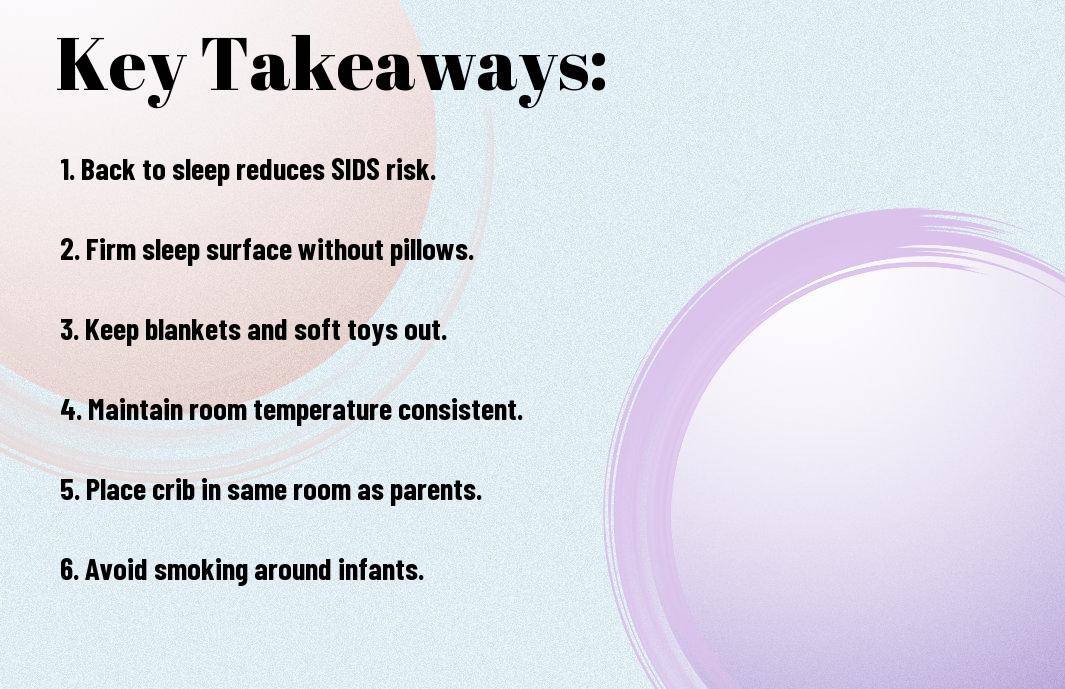tips, tricks and guides for parenthood
Ensuring safe sleep environments for infants is crucial in reducing the risk of Sudden Infant Death Syndrome (SIDS) and other sleep-related incidents. By following strict sleep safety standards and adhering to guidelines set out by experts in paediatrics and child health, parents and caregivers can create a safe sleep space for their little ones. In this blog post, we will explore the importance of adhering to these guidelines and provide practical tips for creating a safe sleep environment for infants, promoting better sleep quality and ensuring peace of mind for parents.

As far as ensuring the safety of your sleeping baby, it is crucial to be aware of the potential risks associated with infant sleep. For comprehensive guidelines on how to keep your sleeping baby safe, refer to How to Keep Your Sleeping Baby Safe - HealthyChildren.org.
Sudden Infant Death Syndrome (SIDS) is a devastating event where an infant under 1 year of age dies suddenly and unexpectedly while sleeping. To reduce the risk of SIDS, it is crucial to follow safe sleep practices such as placing your baby on their back to sleep, using a firm mattress in a safety-approved crib, and avoiding the use of soft bedding or toys in the sleep environment.
Aside from SIDS, there are other sleep-related causes of infant morbidity that parents should be mindful of. These include accidental suffocation, strangulation, and other sleep-related incidents that can be prevented by creating a safe sleep environment and avoiding potential hazards such as loose bedding or overcrowded sleep spaces.
The American Academy of Pediatrics (AAP) recommends that infants should be placed on their back for all sleep times until their first birthday to reduce the risk of Sudden Infant Death Syndrome (SIDS). They also advise against using soft bedding, bumper pads, or loose blankets in the crib to create a safe sleep environment.
Creating a safe sleep environment is crucial for reducing the risk of SIDS. This includes using a firm mattress with a fitted sheet, avoiding overheating the baby, and ensuring there are no toys or pillows in the crib. Additionally, it is recommended that babies share a room with their parents but not the same bed, for at least the first six months.
Healthcare providers play a crucial role in promoting and implementing safe sleep practices for infants. They are responsible for educating parents on the importance of following safe sleep guidelines, such as placing babies on their backs to sleep and ensuring a safe sleep environment free from hazards. Healthcare providers should also regularly monitor and assess the sleeping habits of infants to ensure they are adhering to the recommended safety standards.
Parental education and support strategies are necessary in ensuring that caregivers have the knowledge and skills to create a safe sleep environment for their infants. This includes educating parents on the risks of co-sleeping, the importance of using firm sleep surfaces, and the benefits of keeping soft bedding and toys out of the sleep area. Support strategies may involve providing resources, such as pamphlets or educational sessions, to empower parents to make informed decisions about their child's sleep safety.
It is crucial to track and assess the compliance of safe sleep measures to ensure that infants are protected during sleep. Regular monitoring can help identify any areas of improvement and address non-compliance issues effectively.
Keeping up-to-date with the latest safety standards is paramount in ensuring the continued safety of infants during sleep. Regularly reviewing and revising safety standards based on new research and recommendations helps to provide the best possible guidelines for safe sleep practices.
Updates and revisions to safety standards should be implemented promptly and communicated effectively to all involved parties to maintain a high level of safety in infant sleep environments. This ensures that the most current and evidence-based practices are being followed to reduce the risk of sleep-related incidents.
It is crucial to adhere to sleep safety standards when it comes to infants to reduce the risk of Sudden Infant Death Syndrome (SIDS) and other sleep-related accidents. By following guidelines such as placing babies on their backs to sleep, using a firm and flat sleep surface, keeping soft bedding and toys out of the sleep area, and avoiding overheating, we can create a safe sleep environment for infants. Parents and caregivers play a vital role in ensuring that these standards are followed consistently to promote the well-being and safety of infants during sleep. By prioritising safe sleep practices, we can help reduce the incidence of sleep-related incidents and provide infants with a secure and optimal sleep environment.
A: It is crucial to follow sleep safety standards to reduce the risk of Sudden Infant Death Syndrome (SIDS) and other sleep-related accidents.
A: Some guidelines include placing babies on their backs to sleep, using a firm mattress in a safety-approved crib, and keeping soft bedding and toys out of the crib.
A: Parents can create a safe sleep environment by maintaining a comfortable room temperature, ensuring the baby sleeps on a firm mattress with a fitted sheet, and avoiding co-sleeping.
A: It is recommended to stop swaddling when the baby shows signs of rolling over, usually around 2 months old, to prevent potential hazards during sleep.
A: If parents have any concerns about their infant's sleep safety, they should consult with a paediatrician or healthcare provider for guidance and recommendations specific to their child's needs.